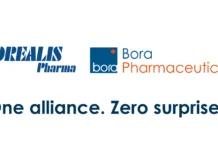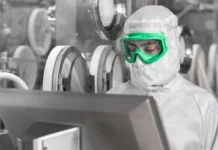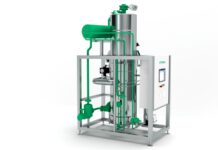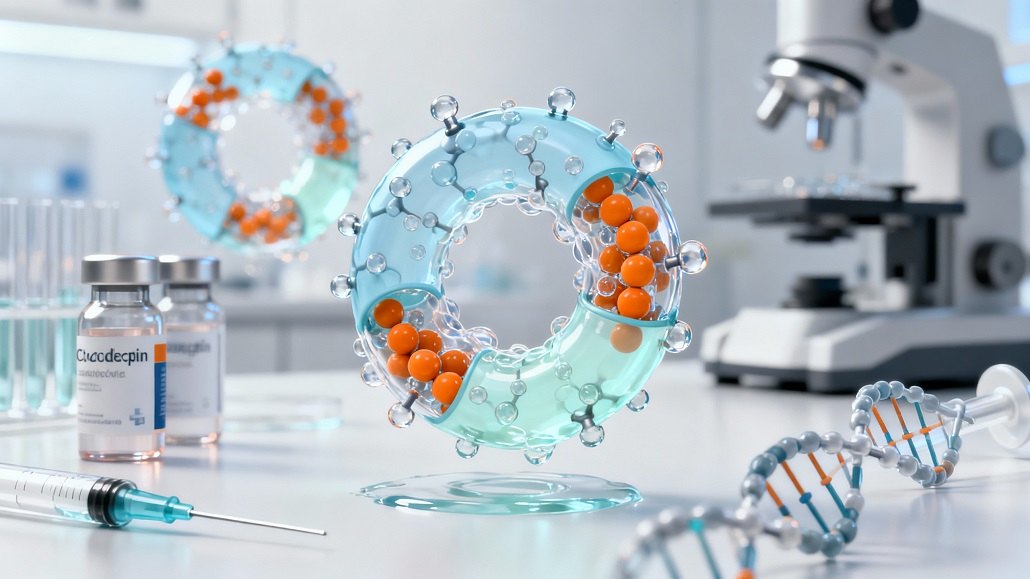
- How exactly do cyclodextrins enhance the bioavailability and therapeutic performance of complex drugs – for example, in advanced platforms like adenovirus vector-based vaccines or gene therapies?
From their fundamental chemistry to even their name, cyclodextrins are “built” for bioavailability enhancement. The prefix “cyclo-” relates to the distinctive ring of glucose chains that give cyclodextrins their structure and unique capabilities. The interior surface of this ring is hydrophobic, allowing it to form complexes with insoluble drug compounds and encapsulate them within the cyclodextrin. The hydrophilic exterior of the ring, on the other hand, is able to form hydrogen bonds with aqueous solvents, creating solutions that are more easily absorbed within the body. It’s this dual action of encapsulation, paired with improved absorption, that makes cyclodextrins particularly effective in keeping (bio)pharmaceutical active ingredients (APIs) soluble, stable and ready to produce the intended effect.
Incredibly useful yet notoriously prone to instability, adenovirus vectors (AdVs) are a great example of where cyclodextrins can provide distinct value as biopharmaceutical excipients. AdVs are modified versions of non-enveloped DNA viruses capable of “infecting” a wide variety of cell types. This positions them as a top choice for vaccine and gene therapy development, but to take full advantage of their many benefits, formulators must shield AdVs from light, heat, physical shear and any other stresses that could compromise the integrity of their outer capsids (protein shells). With their encapsulation and absorption capabilities, cyclodextrins provide the ideal “chaperone” for AdVs throughout the production process and beyond, assuring stability prior to administration, and solubility once taken by patients.
- In what ways can cyclodextrins contribute to simpler, more patient-friendly dosing schedules (such as by shortening treatment regimens or making therapies easier to follow) without compromising efficacy?
The main issue here is bioavailability – or lack of it. Many newly developed APIs – both large and small molecules – exhibit poor solubility, making it difficult to achieve adequate dosing in a small, convenient format. Harnessing cyclodextrins’ inherent encapsulation properties and affinity for complex molecules is one way drug developers can overcome this dosing hurdle and deliver more patient-friendly therapies. Again, using AdVs as a case study, improving vector integrity through the incorporation of cyclodextrins helps ensure consistent potency, leading to more reliable therapeutic outcomes. A stable vector is also less likely to degrade into non-infectious fragments, which could otherwise trigger unwanted immune responses or toxicity, thereby reducing the risk of side effects like inflammation or cytokine storms. Heighted stability also supports more durable gene expression from AdVs, reducing the need for repeat dosing, boosting the likelihood of compliance and vastly improving the patient experience.
- Could you explain how cyclodextrins can contribute to improved stability and shelf life – and how that translates into better access for patients, particularly in regions where cold-chain logistics are challenging?
Cyclodextrins such as hydroxypropyl beta-cyclodextrin (HPβCD) offer a promising way to enhance the stability and shelf life of biologic formulations – particularly monoclonal antibodies and viral vectors -by acting as protective “chaperones” for sensitive proteins. During key manufacturing steps like ultrafiltration/diafiltration (UF/DF), biologic drugs are exposed to significant shear stress, which can cause proteins to unfold or aggregate, compromising efficacy. Traditional stabilizers like polysorbates 20 or 80 often fall short at this stage, as they can form large micelles or become trapped in filter membranes, leading to inconsistencies and membrane fouling.
HPβCD, by contrast, passes cleanly through UF/DF membranes and helps preserve protein integrity by shielding molecules from interfacial stress. In comparative studies, HPβCD-stabilized AdV formulations maintained potency under heat and light stress, outperforming polysorbate-based counterparts.
This improved thermal and photostability translates directly into better access for patients. More robust formulations reduce reliance on cold-chain logistics, potentially allowing vaccines and biologics to be stored and distributed at ambient temperatures. For regions where refrigeration is limited, this means greater treatment availability, faster deployment during outbreaks, and ultimately, more equitable access to life-saving therapies.
- Looking ahead, how might cyclodextrins support the development of new delivery formats, such as oral biologics or needle-free therapeutics? What technical hurdles are they helping to overcome?
Cyclodextrins are playing a crucial role in advancing the next generation of needle-free vaccines and therapeutics by helping formulators overcome long-standing technical barriers. Developing oral or intranasal biologics is notoriously challenging[11] – active ingredients must withstand stresses from the likes of wet and dry granulation, direct compression and high-throughput manufacturing, all while maintaining bioavailability and stability.
Through their unique stabilization properties, cyclodextrins can protect sensitive biologic molecules and enhance solubility giving them potential as excipients when developing oral or other non-parenteral vaccines.
For patients, this innovation promises greater comfort and accessibility, eliminating needle-related anxiety while broadening global vaccine reach through more convenient, stable, and easily administered dosage forms.
- Given their versatility, do you see cyclodextrins becoming a standard tool in biopharma R&D and innovation, not just practical delivery?
In short – they already are! Across large and small molecule drug manufacturing, we’re increasingly seeing cyclodextrins selected over conventional surfactants and solubility enhancers, but their potential extends far further up the development pipeline. Oral to ophthalmic, parenteral to topical, researchers are exploring a whole host of novel applications for cyclodextrins, recognizing their emerging potential in targeted-, controlled- and sustained-release therapies. It’s safe to say, there are more sides to these super, cyclical molecules out there for drug developers to explore, and for patients to benefit from!
All Quotes are attributed to: Tao Peng, Senior Biopharma Research Manager, Health & Pharma Solutions Business Group at Roquette




















